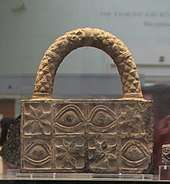The Babylonian Marriage Market
The Babylonian Marriage Market is an 1875 painting by the British painter Edwin Long of young women being auctioned into marriage. It received attention for its provocative depiction of women being sold and its attention to historical detail.
| The Babylonian Marriage Market | |
|---|---|
 | |
| Artist | Edwin Long |
| Year | 1875 |
| Location | Royal Holloway College |
The painting
The painting was inspired by a passage in the Histories by Herodotus,[1] and the artist painstakingly copied some of the images from Assyrian artefacts in the British Museum.[2] The composition is also influenced by Victorian painting auctions.[3]
The painting made its public debut at the Royal Academy in 1875, where it drew large crowds and won widespread acclaim.[4] The art critic John Ruskin praised the painting and highlighted the similarity between its subject matter and modern European marriage practices, which Ruskin thought were also mercenary and immoral.[5]
It is currently held in the Picture Gallery of Royal Holloway College, after being bought by Thomas Holloway in 1882, where it fetched a then-record price for a painting by a living artist at £6,615.[6] Holloway's reasons for giving this work to Royal Holloway College (a women-only college that he had founded) are still debated by historians.[7] Although the painting is usually interpreted as a faithful illustration of the passage in the Histories, Imogen Hart suggests that it in fact modifies and critiques Herodotus's description.[7]
Borrowings and influences

The painting incorporated several designs known from ancient artifacts. The motif of a carved stone with handle, probably of Elamite origin, and found in a foundation deposit of the Sumerian king A'annepada (circa 2500 BCE), was reused in the decoration of the white platform at the center of the painting.[9][10]
The silent film Intolerance (1916) includes a seven‐and‐a‐half‐minute scene closely based on this painting.[7][11]
References
- "Babylonian Marriage Market". Royal Holloway, University of London. Retrieved 12 September 2015.
- Histories Clio I 196, Herodotus
- David Gange; Michael Ledger-Lomas, eds. (2013). Cities of god : the Bible and archaeology in nineteenth-century Britain. Cambridge Univ Press. ISBN 978-1316625651. OCLC 959835440.
- Huda, Shireen (2008). Pedigree and Panache: A History of the Art Auction in Australia. ANU Press. doi:10.26530/oapen_459437. ISBN 9781921313721.
- Richards, J. (2016). Ancient world on the victorian and edwardian stage. PALGRAVE MACMILLAN. ISBN 978-1349310784. OCLC 956747884.
- Gilmartin, Sophie (2005). Ancestry and narrative in nineteenth-century British literature: blood relations from Edgeworth to Hardy. Cambridge University Press. ISBN 9780521023573. OCLC 265995152.
- Vanderbilt, Tom (2016). You may also like. Alfred A. Knopf. p. 152. ISBN 9780307958242.
- Hart, Imogen (2011-12-08). "The Politics of Possession: Edwin Long's Babylonian Marriage Market". Art History. 35 (1): 86–105. doi:10.1111/j.1467-8365.2011.00872.x. ISSN 0141-6790.
- Collections Online British Museum.
- Museum notice
- Collections Online British Museum.
- Marta García Morcillo; Pauline Hanesworth; Óscar Lapeña Marchena, eds. (2015). Imagining ancient cities in film : from Babylon to Cinecittà. Routledge. ISBN 9780415843973. OCLC 930864593.